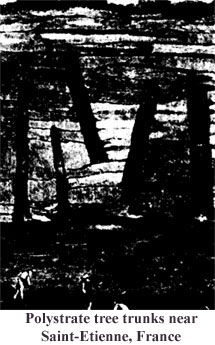
 |
Anomalies and Misplaced Fossils
An "anomaly" is a deviation or irregularity, i.e., something that shouldn't be where it is. A "misplaced fossil" is a fossil or imprint which is located in strata supposedly millions of years out of the defined geologic timetable. Listed below are several examples of anomalies and misplaced fossils.
Dr. Clifford Burdick, a geologist, discovered the footprints of a barefooted child, one of which contained a compressed trilobite (A. E. Wilder-Smith, The Natural Scientists Know Nothing of Evolution, Master Books, San Diego, CA, 1981, p. 166). Trilobites supposedly became extinct 230 million years before the appearance of man.
William Meister, on June 1, 1968, found fossils of several trilobites in the fossilized, sandaled footprint of a man. (W. A. Criswell, Did Man Just Happen? Zondervan Publishing Co., Grand Rapids, MI, 1973, p. 87). Trilobites supposedly became extinct 230 million years before the appearance of man.
 Polystratic
Trees, fossilized trees which extend through several layers of strata, have
been found in Saint-Etienne, France and other places. For a fossil to form it
must be buried quickly, otherwise it would have decomposed while waiting for
the strata to slowly accumulate around it. This is an anomaly which can't be
explained by the normal process of fossil formation. In some cases polystratic
trees bridge a presumed evolutionary time span of millions of years. Polystratic
trees are evidence that sedimentary strata were not laid down gradually over
millions of years. (R. L. Wysong, The Creation-Evolution Controversy,
Inquiry Press, Midland, MI, 1981, p. 300-301.)
Polystratic
Trees, fossilized trees which extend through several layers of strata, have
been found in Saint-Etienne, France and other places. For a fossil to form it
must be buried quickly, otherwise it would have decomposed while waiting for
the strata to slowly accumulate around it. This is an anomaly which can't be
explained by the normal process of fossil formation. In some cases polystratic
trees bridge a presumed evolutionary time span of millions of years. Polystratic
trees are evidence that sedimentary strata were not laid down gradually over
millions of years. (R. L. Wysong, The Creation-Evolution Controversy,
Inquiry Press, Midland, MI, 1981, p. 300-301.)
In Glacier National Park, Pre-Cambrian limestone (supposedly 1 billion years old) is lying on top of a Cretaceous shale formation (supposedly 100 million years old). Geologists attempt to explain this anomaly as an overthrust, where a fault causes the older strata to be thrust over the younger strata. However, this "misplaced" limestone is 350 miles long and 35 miles wide, and shows no signs of grinding or sliding that a true overthrust would produce. This discrepancy cannot be explained by overthrusting. (Scott M. Huse, The collapse of Evolution, Baker Book House, Grand Rapids, MI, p. 15-16).
During mining operations in a quarry in Lompoc, California in 1976, workers discovered a fossilized skeleton of a baleen whale. What is so unusual about this discovery is that the whale fossil wasn't lying horizontally, but vertically--standing on its tail! The entire fossil is about eighty feet long and was gradually exposed as the quarry was being mined. The whale had to have been buried quickly to become fossilized, otherwise the skeleton would have decomposed. This proves that the huge amounts of sediment surrounding the whale were not deposited over eons of time, but very quickly. (Dennis Gordon Lindsay, The Birth of Planet Earth and the Age of the Universe, Dallas: Christ for the Nations, 1993, p. 18-20.)
A 75-foot trail of human footprints have been found in Tanzania in a layer of volcanic ash, which was dated at 3.75 million years old. T. D. White in describing the footprints said, "Make no mistake about it…they are like modern human footprints. If one were left in the sand of a California beach today, and a four-year old were asked what it was, he would instantly say that somebody had walked there. He wouldn't be able to tell it from a hundred other prints on the beach, nor would you." (D. Johanson and M. A. Edey, Lucy the Beginnings of Humankind, Simon and Schuster, New York, 1981, p. 250, as sited in Evolution: The Challenge of the Fossil Record by Duane T. Gish).
Human footprints and been found in the same strata as dinosaur prints in the Paluxy River Bed in Glen Rose, Texas. The prints are within a few yards of each other, and sometimes even cross each other. Dr. Camp from the University of California and Dr. G. Westcott of Ypsilanti, Michigan have pronounced them genuine. The human footprints continue under shale that has been bulldozed away, proving they could not have been carved in the formation. (Winkie Pratney, Creation or Evolution? The Fossil Record, Pretty Good Printing, 1982).
Human skulls, gold chains, and an iron pot have been found in coal. In the coal collection in the Mining Academy in Freiberg, there is a human skull composed of brown coal and manganiferous and phosphatie limonite. This skull was described by Karsten and Dechen in 1842. (Otto Stutzer, Geology of Coal, Chicago: University of Chicago, 1940, p. 271). In 1889 a Mrs S.W. Culp broke open a chunk of coal and found a 10 inch, eight-carat gold chain embedded within. ("A Necklace of a Prehistoric God", Morrisonville Times, Illinois, June 11, 1891).
Two fossilized human skeletons have been found in Cretaceous sandstone at Moab, Utah. The fossils were found in strata supposedly 65-100 million years before humans were said to have evolved. (Burdick, C.L., "Discovery of human skeletons in Cretaceous Formation", Creation Research Society Quarterly, vol. 10, no. 2, September 1973, pp. 109-110.)
Dinosaur fossils have been found 400 miles from the South Pole. The polar plains now scoured by frigid winds and sub-zero temperatures were warm enough 200 million years ago to be the home to large meat-eating dinosaurs, according to researchers. It was the first dinosaur found on the mainland of Antarctica. (Associated Press, May 6, 1994).